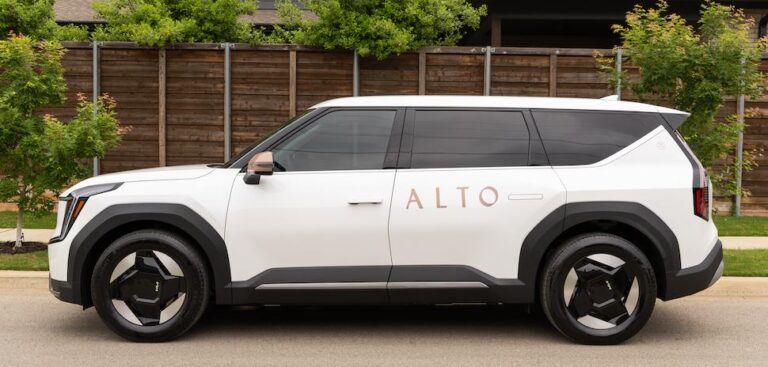Alto’s Bold Move: Launching an All-Electric Fleet to Revolutionize Urban Ride-Hailing
Alto has recently unveiled its inaugural fleet composed entirely of electric vehicles (EVs), signaling a pivotal transformation in its approach to urban transportation. This initiative underscores the company’s dedication to minimizing environmental impact while offering riders a cleaner, quieter alternative to traditional gasoline-powered cars. As the ride-hailing sector increasingly prioritizes sustainability, Alto’s EV rollout positions it at the forefront of green mobility innovation.
Driving Change: How Alto’s Electric Fleet is Reshaping the Ride-Hailing Landscape
The introduction of Alto’s fully electric fleet represents a major evolution in the ride-hailing industry, reflecting a broader shift toward eco-conscious urban transit solutions. By adopting EVs, Alto aims to significantly cut down on greenhouse gas emissions and reduce operational expenses, setting a new benchmark for competitors. This strategic pivot is likely to accelerate the adoption of electric vehicles across the sector, fostering a more sustainable future for urban mobility.
Key benefits of Alto’s electric fleet include:
- Reduced operational costs: EVs require less maintenance and eliminate fuel expenses, lowering overall expenditures.
- Enhanced ride quality: Electric motors provide quieter, smoother journeys, improving comfort for passengers and drivers alike.
- Access to incentives: Government rebates and tax credits support the financial viability of sustainable fleet operations.
| Aspect | Alto’s EV Fleet | Conventional Fleet |
|---|---|---|
| Typical Driving Range | Approximately 230 miles | Unlimited (gasoline refuel) |
| Maintenance Interval | Every 15,000 miles | Every 5,000 miles |
| Tailpipe Emissions | Zero | Significant CO2 output |
| Cost per Mile | About $0.05 | Approximately $0.12 |
Environmental and Financial Benefits of Alto’s Electric Fleet in Urban Settings
Transitioning to an all-electric fleet enables Alto to make a substantial impact on urban air quality and carbon emissions. The company projects an annual reduction exceeding 2,700 metric tons of CO2, contributing to cleaner air and quieter streets in densely populated cities. This aligns with global efforts to combat climate change and enhances residents’ quality of life by reducing smog and noise pollution.
From an economic standpoint, while the upfront costs of EV acquisition and charging infrastructure are considerable, the long-term savings on fuel and maintenance are significant. These efficiencies can lead to more affordable ride fares and better earnings for drivers. Additionally, Alto’s green commitment is likely to attract a growing segment of environmentally aware consumers, strengthening brand loyalty and expanding market share.
| Metric | Gasoline Fleet | Electric Fleet |
|---|---|---|
| Annual CO2 Emissions | 3,600 metric tons | Under 900 metric tons |
| Average Maintenance Cost per Vehicle | $1,250 | $650 |
| Energy Cost per Mile | $0.16 | $0.05 |
| Noise Pollution Level | High | Minimal |
Overcoming Obstacles and Seizing Opportunities in Scaling Alto’s Electric Ride-Hailing Service
Despite the promising benefits, Alto faces several hurdles in expanding its electric fleet. The establishment of a widespread, reliable charging network is critical but challenging, requiring strategic placement and significant capital investment. Unlike quick gasoline refueling, EV charging demands longer downtime, which could affect vehicle availability. Additionally, fluctuating electricity prices and urban grid capacity constraints must be managed carefully to maintain cost-effective operations and competitive pricing.
Conversely, these challenges open doors for innovation and strategic partnerships. Collaborations with utility companies and adoption of smart charging technologies can optimize energy consumption and reduce costs. Government incentives for EV adoption and infrastructure development further support Alto’s transition. The table below outlines key challenges alongside potential solutions that can help Alto balance growth with sustainability goals.
| Challenge | Strategic Opportunity |
|---|---|
| Building charging infrastructure | Partnering with local utilities and deploying smart chargers |
| Limited battery range | Incentivizing use of fast-charging EV models |
| High initial investment | Leveraging government subsidies and long-term cost savings |
| Electric grid demand spikes | Encouraging off-peak charging to balance load |
Actionable Strategies for Ride-Hailing Firms Embracing Electric Mobility
For ride-hailing companies aiming to adopt sustainable transportation, forging strong alliances with EV manufacturers and charging network providers is essential. These partnerships ensure access to the latest electric vehicle technology and convenient charging options for drivers. Equally important is investing in comprehensive driver education programs focused on EV operation and maintenance to maximize vehicle lifespan and efficiency. Utilizing real-time analytics to track fleet performance and environmental impact can further enhance operational decision-making.
Recommended strategic initiatives include:
- Implementing incentives to motivate drivers to transition to electric vehicles.
- Advocating for supportive policies and financial incentives that promote electric mobility.
- Rolling out EV adoption in phases to manage costs and operational adjustments smoothly.
- Raising customer awareness about the environmental advantages of choosing electric rides.
| Strategy | Expected Benefit | Implementation Timeline |
|---|---|---|
| Collaborations with EV Manufacturers | Access to cutting-edge electric vehicle models | Short-term (0-6 months) |
| Driver Training Programs | Enhanced vehicle performance and reduced maintenance costs | Medium-term (6-12 months) |
| Investment in Charging Infrastructure | Minimized vehicle downtime and improved fleet availability | Long-term (12+ months) |
Conclusion: Alto’s Electric Fleet as a Catalyst for Sustainable Urban Transportation
Alto’s pioneering launch of an all-electric ride-hailing fleet represents a significant milestone in the evolution of urban mobility. As consumer demand for environmentally responsible transportation grows and regulatory frameworks tighten, this initiative sets a powerful example for the industry. The coming months will reveal how Alto’s commitment influences competitors and shapes the future of sustainable ride-hailing services worldwide.







